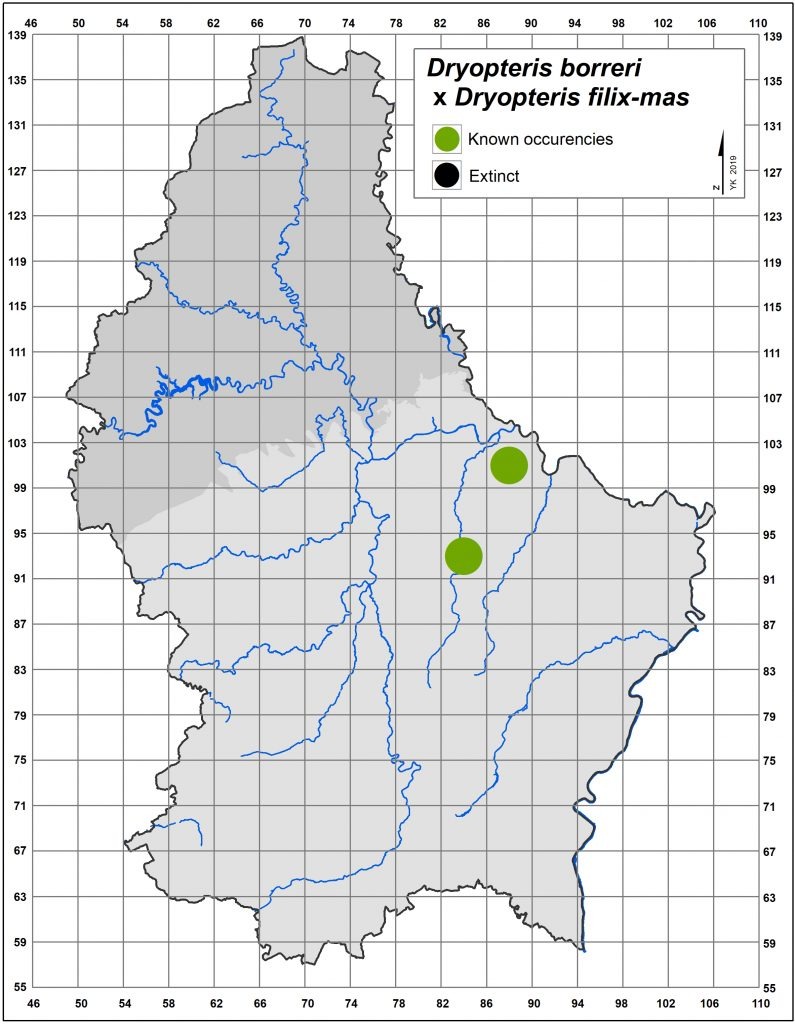 Trichomanes speciosum Willd.
Trichomanes speciosum Willd.
 Killarney fern
Killarney fern
 Trichomanès remarquable
Trichomanès remarquable
 Prächtiger Dünnfarn
Prächtiger Dünnfarn
 Aparten Hautfar
Aparten Hautfar
Class: Polypodiopsida
Family: Hymenophyllaceae
Status
LRlc – lower risk least concern

Description
 Although primarily a species of the UK, Ireland, Brittany and the Atlantic Islands (Canaries, Madeira and the Azores), the filmy ferm Trichomanes speciosum Willd. (Killarney fern) [Photo 1] is also found in Europe at scattered locations in other parts of France, Spain, Portugal and Italy.
Although primarily a species of the UK, Ireland, Brittany and the Atlantic Islands (Canaries, Madeira and the Azores), the filmy ferm Trichomanes speciosum Willd. (Killarney fern) [Photo 1] is also found in Europe at scattered locations in other parts of France, Spain, Portugal and Italy.
The gametophytic generation of Trichomanes speciosum Willd. [Photo 2] (Syn.: Vandenboschia speciosa) can be found independently of the sporophyte and seems to be widespread in Europe – in contrast to the sporophyte. It appears however to exist in a state of arrested development, unable to produce the mature form under present conditions.
Trichomanes speciosum Willd. is listed on Annexes II and IV of the Habitats Directive and Appendix I of the Bern Convention. It is listed as rare on the IUCN global RDL.
 In Luxembourg the independent gametophyte of Trichomanes speciosum was first discovered in 1993 [Jermy, Rasbach, Rasbach & Viane (unpubl.)]. In 1994 some new locations were found [Colling, G. & L. Reichling, 1996. – Notes floristiques 1994-1995. – Bull. Soc. Nat. luxemb., 97: 25-38]. So, in late 1999 a project was launched, to investigate the sandstone region, commonly called ‘Petite Suisse’, in Luxembourg in order to fix the distribution area of the gametophyte. Many new locations of the gametophyte were found. Most of the sites occur in the ‘Petite Suisse’ area, but the independent gametophyte of Trichomanes speciosum is largely present in the whole sandstone area as far as the valley of the river Alzette. The discoveries of the gametophyte on Devonian schist showed that the species is quite widespread in the Luxembourg’s Ardennes too.
In Luxembourg the independent gametophyte of Trichomanes speciosum was first discovered in 1993 [Jermy, Rasbach, Rasbach & Viane (unpubl.)]. In 1994 some new locations were found [Colling, G. & L. Reichling, 1996. – Notes floristiques 1994-1995. – Bull. Soc. Nat. luxemb., 97: 25-38]. So, in late 1999 a project was launched, to investigate the sandstone region, commonly called ‘Petite Suisse’, in Luxembourg in order to fix the distribution area of the gametophyte. Many new locations of the gametophyte were found. Most of the sites occur in the ‘Petite Suisse’ area, but the independent gametophyte of Trichomanes speciosum is largely present in the whole sandstone area as far as the valley of the river Alzette. The discoveries of the gametophyte on Devonian schist showed that the species is quite widespread in the Luxembourg’s Ardennes too.
The results of the different investigations, with a description of the gametophyte, the history of its discovery, the present distribution and status in Luxembourg and the neighbouring regions can be found in following publications:
- Krippel, Y., 2001. Aire de répartition et statut de Trichomanes speciosum Willd. (Hymenophyllaceae) au Luxembourg. Bull. Soc. Nat. luxemb. 102: 3-13. [PDF 551 Kb]
- Krippel, Y., 2005. – The Hymenophyllaceae (Pteridophyta) in Luxembourg – Past, present and future. – In: Ries C. & Y. Krippel (Editors), 2005. – Sandstone Landscapes in Europe – Past, Present and Future. Proceedings of the 2nd International Conference on Sandstone Landscapes. Vianden (Luxembourg) 25-28.05.2005. – Ferrantia. Trav. Scientif. Mus. Hist. Nat. Lux. 44: 209-214.
- Krippel, Y., 2009. – Trichomanes speciosum Willd. (Hymenophyllaceae) au G.-D. de Luxembourg, en Belgique et dans les régions avoisinantes. – Adoxa, 61: 9-13.
Further information
Syn.: Vandenboschia speciosa (Willd.) G. Kunkel
 Dryopteris pseudodisjuncta (Tavel ex Fraser-Jenkins) Fraser-Jenkins
Dryopteris pseudodisjuncta (Tavel ex Fraser-Jenkins) Fraser-Jenkins Elegant Scaly Male-fern
Elegant Scaly Male-fern Dryoptéris écailleux élégant
Dryoptéris écailleux élégant  Eleganter Schuppen-Wurmfarn
Eleganter Schuppen-Wurmfarn Elegante Schuppe-Wuermfar
Elegante Schuppe-Wuermfar







![Diphasiastrum complanatum (L.) Holub [extr. herb. Kotz]](https://pteridophytes.lu/wp/wp-content/uploads/Extrait-herb-Koltz-Lycopodium-complanatum-lr-150x150.jpg) Diphasiastrum complanatum
Diphasiastrum complanatum 


 Although primarily a species of the UK, Ireland, Brittany and the Atlantic Islands (Canaries, Madeira and the Azores), the filmy ferm Trichomanes speciosum
Although primarily a species of the UK, Ireland, Brittany and the Atlantic Islands (Canaries, Madeira and the Azores), the filmy ferm Trichomanes speciosum  In Luxembourg the independent gametophyte of Trichomanes speciosum was first discovered in 1993 [Jermy, Rasbach, Rasbach & Viane (unpubl.)]. In 1994 some new locations were found [Colling, G. & L. Reichling, 1996. – Notes floristiques 1994-1995. – Bull. Soc. Nat. luxemb., 97: 25-38]. So, in late 1999 a project was launched, to investigate the sandstone region, commonly called ‘Petite Suisse’, in Luxembourg in order to fix the distribution area of the gametophyte. Many new locations of the gametophyte were found. Most of the sites occur in the ‘Petite Suisse’ area, but the independent gametophyte of Trichomanes speciosum is largely present in the whole sandstone area as far as the valley of the river Alzette. The discoveries of the gametophyte on Devonian schist showed that the species is quite widespread in the Luxembourg’s Ardennes too.
In Luxembourg the independent gametophyte of Trichomanes speciosum was first discovered in 1993 [Jermy, Rasbach, Rasbach & Viane (unpubl.)]. In 1994 some new locations were found [Colling, G. & L. Reichling, 1996. – Notes floristiques 1994-1995. – Bull. Soc. Nat. luxemb., 97: 25-38]. So, in late 1999 a project was launched, to investigate the sandstone region, commonly called ‘Petite Suisse’, in Luxembourg in order to fix the distribution area of the gametophyte. Many new locations of the gametophyte were found. Most of the sites occur in the ‘Petite Suisse’ area, but the independent gametophyte of Trichomanes speciosum is largely present in the whole sandstone area as far as the valley of the river Alzette. The discoveries of the gametophyte on Devonian schist showed that the species is quite widespread in the Luxembourg’s Ardennes too.






